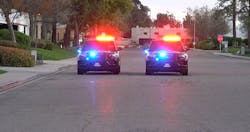Calming the Chaos: How Patrol Vehicle Lighting is Evolving
Over the past decade, patrol vehicle lighting has undergone a myriad of changes. From the introduction of LED lights to the ability to control the lighting patterns, brightness and color, these systems have become both more customizable and more complicated. Now, law enforcement agencies can synchronize lights of multiple vehicles and convey a united message on the scene of an incident or while responding to a call.
Matt Ayers, Lead Product Trainer and Applications Consultant for SoundOff Signal, noted that as law enforcement vehicles have evolved, it’s become even more important for officers to manage the message sent out to the public when it comes to warning signals. He says that the idea of de-escalation can even be applied to vehicle lighting. “It breaks down to how you communicate, how you send messages and when it comes to law enforcement warning lights particularly, de-escalation concepts have really not been applied,” he says. “I’ve interviewed people at fatal crash scenes and noticed they can’t put a coherent thought together. I watch their eyes and they are constantly looking past me towards the flashing lights.“I realized that we need to turn the lights off or down when we are interviewing people and getting information from them because, whether they know that they are distracted or not, they are distracted. It’s just like if the siren was still going on in the background, how easy would it be to have a conversation with someone? People are visual creatures, and the whole time those lights are flashing, it is the equivalent of the siren being on as far as a distraction. You have to have strategies to manage that.”
For Ayers, making law enforcement lighting more uniform and controlled is personal. His wife has an inner ear disorder called Ménière's disease that causes her to be sensitive to rapid movements in her vision as well as anything that throws her off balance. At night, if she’s driving by police cars on the side of the road and the lights of multiple vehicles are activated, she has to turn her head sideways, look out the driver’s side window so she can drive down the road and block the lights with her hand. “When she’s doing that, she isn’t safer, and the police officers aren’t safer,” he says. “Therefore, nobody is safe because of those lights and in that particular instance, everybody might be safer with no lights at all.”
Ayers says that of the two extremes—patrol car with lights activated at high brightness without controlled patterns and no lights at all—neither one is the right choice, so how do we manage and tone down that signal in order to, as he puts it, “calm the chaos?” He says that intelligent control offers the tools to do just that.Creating a foundation
Introduced in 2013, SoundOff Signal’s bluePRINT system put everything in the control system of the vehicle in one place. Ayers says that before systems like bluePRINT, lightbars, surface mount lights and all of the connected accessories in a patrol vehicle operated on their own and were wired without consideration for the others. In order to alleviate this problem, bluePRINT was created to consolidate everything into one system. He also noted that the advancement of LED lights, not only as the primary source of warning power, but also their ability to be in multiple colors and their ability to have variable intensity posed some challenges that bluePRINT was designed to manage.
“If you were to take a police car from circa 2004, you would notice that there were probably only six or so switches in the entire police car dedicated to lights. That would include your takedowns, your alley light left, your alley light right and arrow,” he says. “That really wasn’t enough to control the multi-color LEDs where you could have warning modes, cruise modes, low-power modes and scene overrides.”
With bluePRINT, officers were given the ability to manage the colors while also control the intensity of the lighting. It created a consolidated input and output hub for the emergency vehicles that managed power distribution of connected components and also offered the ability to control, coordinate and synchronize the flashing of all connected lights to include having steady override of scene lighting. The system also controls the siren and can interact with cameras, radar, radios, printers and other devices. The system further gave the user the ability to write logic events or logic-driven occurrences into the software. This allows the user to take multiple inputs in the vehicle and make a new virtual input that would only work if those multiple, independent inputs were active.
Getting in Sync
SoundOff Signal’s bluePRINT Sync, an add-on component to bluePRINT, was first demonstrated to the industry at Police Fleet Expo in St. Louis in 2018. By plugging in a CAT-5 cable and installing a GPS antenna inside the car, the new product offered the ability put multiple patrol cars running bluePRINT on the same flash schedule.
While Ayers uses the term ‘intelligent control,’ he steers away from the term ‘artificial intelligence’ because the systems don’t interact with each other. “SoundOff Signal’s bluePRINT system mastered control of the lights on the individual vehicle using automation and vehicle system information. It lets agencies predetermine how their warning system should operate for a given mobile tactical problem. That is hugely important for any emergency responder because there are so many other important tasks for them to handle, focusing on the buttons and switches in their car should not be something that they have to pay a lot of attention to. The system is capable of, and should, make that job much simpler by offering pre-thought-out feature sets.
“Once we had the agency’s preferred programming, then we could standardize it in the fleet. Now every vehicle is going to be the same. All they do is connect and program, and it will work the way they want it to work.”
bluePRINT Sync is a passive device that captures and uses GPS time to create a universal timing reference for bluePRINT. It will work anywhere in the world and only requires a GPS signal about every 8 hours to maintain the effect. Sync’s timing simply overrides the system’s default internal clock to give a uniform standard to all Sync-equipped vehicles, allowing a department to fully synchronize the light patterns of multiple vehicles.
“We have found in conversations with high-level federal customers that they cannot have a system that communicates. bluePRINT Sync is passive, it simply takes the time and internalizes it; it doesn’t track, it doesn’t broadcast data, it doesn’t transmit position, it doesn’t know its position. It simply knows what time it is. This point is an absolute must for many customers because if the system communicated car-to-car, it would be a barrier to adoption. Nobody wants anything that is hackable or trackable. bluePRINT Sync is secure in that sense.”
Barriers to adoption
While a lot of law enforcement agencies use the bluePRINT system, adoption of bluePRINT Sync has faced some obstacles. While Ayers says that agencies are increasingly selecting Sync going forward, the biggest barrier has been cost. Not the cost of the individual modules, but the need to retrofit a department’s entire fleet. Larger departments are unlikely to retrofit all of its units and it could take up to several vehicles cycles to see a real benefit if it decides to install bluePRINT Sync going forward.
“Sync is becoming more prominent, and people are putting it in moving forward because they recognize its benefit," he says. "It’s affordable and it’s available now."
In order to install bluePRINT Sync, the unit must already have the bluePRINT 3 system. Older, bluePRINT 2 systems can be easily upgraded. The biggest challenge for an agency will be reworking their programming to take full advantage of bluePRINT Sync.
In addition to working with existing bluePRINT systems, bluePRINT Sync is also fully compatible with SoundOff Signal’s new 500 Series Siren, which has bluePRINT built in. Ayers believes that the 500 Series Siren will be popular due to simplicity and reduced cost, as well as added features. “The 500 Series Siren was built with Sync in mind and has a powerful new programming app to help maximize system benefits.”
Putting it all together
Before joining SoundOff Signal, Ayers was a captain and oversaw the fleet of the Sevierville Police Department in Tennessee for close to 18 years. The agency, which has a 70-vehicle fleet, is currently switching to bluePRINT and bluePRINT Sync. By the end of the spring they will have 20 vehicles running the systems. In November, he was at the agency to film nighttime drone video of the system in action. Ayers noticed that people were pulling off the main highway that was about a quarter mile away to see what was going on. People would ask what they were doing and noticed that the lights on the vehicles were flashing at the same time.
“It was a conversation I had multiple times that night. It stunned me that everybody recognized that something was different. Not all of them could pinpoint that the flash patterns were coordinated, but they all recognized that there was some coherence to the event,” he says. “Several of them pointed out that it was better than seeing all of the crazy lights on the road. When I explained the effect to them and what was happening, it put the puzzle pieces together and they started completing my thoughts with some of the concepts I’ve been advocating.”
He said that the response in just that two-hour window was overwhelming. “It’s just phenomenal that people who see this get it… I’m amazed every time I see it work. I just can’t believe how well it works to improve signal messages.”
Visit officer.com/21209810 to see bluePRINT Sync in action


